#jfk assassination
Text

703 notes
·
View notes
Text
William Cooper 🤔
#pay attention#educate yourselves#educate yourself#knowledge is power#reeducate yourself#reeducate yourselves#think about it#think for yourselves#think for yourself#do your homework#do some research#do your own research#ask yourself questions#question everything#jfk#jfk assassination#inside job#cia#you decide#history lesson#american history#world history#hidden history#news#cover up
277 notes
·
View notes
Text

#klaus hargreeves#five hargreeves#allison hargreeves#diego hargreeves#jfk assassination#the umbrella academy#tumblr memes#tua netflix#tua memes#umbrella acedmy
7K notes
·
View notes
Text
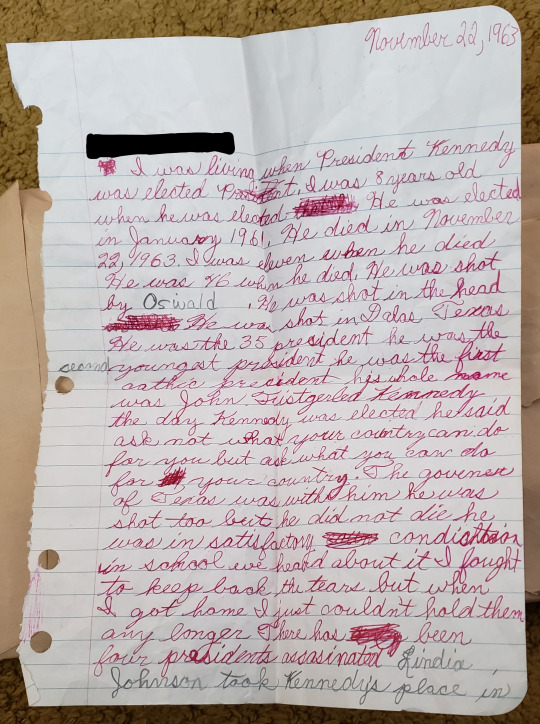
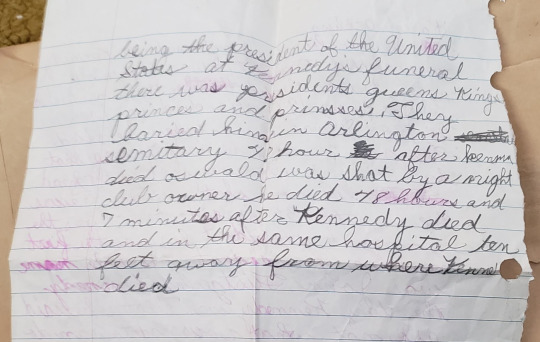
An essay my mom wrote when she got home from school on the day Kennedy was shot, and updated later in the week.
I love the blank space she left for the shooter's name because it hadn't been released yet.
#also featuring my grandfather's shag carpeting from roughly the same time period#this day in history#well technically tomorrow but I'm posting it now#1960s#history#JFK#jfk assassination#kids
210 notes
·
View notes
Text

"He wept after seeing a photograph of his late brother in the office of a former aide, wept when asked to comment on the Warren Commission report, and wept after eulogizing JFK at the 1964 Democratic convention with a quotation from Shakespeare's Romeo and Juliet: "When he shall die, take him and cut him into little stars, and he will make the face of heaven so fine that all the world will be in love with the night and pay no attention to the garish sun."'
The Last Campaign, Thurston Clarke
#robert kennedy#jfk assassination#60 years ago today#I always think about him on the anniversary#bobby kennedy#rfk
90 notes
·
View notes
Text

“ I don’t think Jackie ever really got over the assassination. I suppose maybe, she found a way to move on.” - John Davis
#jackie kennedy#john f kennedy#vintage#icons#the kennedys#jackie o#1960s#60s#60s icons#jfk#jackie onassis#first lady#american president#jacqueline kennedy#style icon#jfk assassination#60s vintage#60s hair#60s photography#1960s icons#1960s hair#vintage gif#vintage celebrities#iconic couple#vintage fashion#vintage style
144 notes
·
View notes
Text
"Thank you Mr. President"
Jackie Kennedy's letter to LBJ less than 24 hours after burying JFK

When Lyndon Baines Johnson was sworn in as President on board Air Force One at Love Field in Dallas, Texas on November 22, 1963, Jackie Kennedy was standing next to him, her pink Chanel dress, white gloves, and bare legs smeared with the blood and brain matter of her assassinated husband. Traumatized and almost certainly in shock, Jackie wanted to support the new President and new First Lady as power was officially transferred in the same solemn ceremony that has always marked such an occasion in American History. As the Presidential airplane left Dallas and returned to the nation's capital, Jackie sat in the back of the plane with the coffin containing her husband's body.
Despite her deep personal loss, her traumatic experience, and her obvious physical exhaustion, Jackie threw herself into planning President Kennedy's funeral as soon as she returned to Washington, D.C. Jackie was sensitive to the needs of the country and protective of her husband's legacy. When she arrived at the White House, she requested information about the exact specifications of Abraham Lincoln's funeral after he was assassinated in 1865. Even though it was the middle of the night, Kennedy staffers went to the National Archives and the Library of Congress to research the Lincoln funeral and Jackie helped make plans for the pageantry that would commence over the next few days. With a few minor exceptions, JFK's funeral was nearly an exact replica of Lincoln's funeral almost 100 years earlier. The effect was monumental. Kennedy's funeral will always be remembered as a dignified, iconic moment in our nation's history.
As Jackie Kennedy prepared to bury the 35th President, Lyndon Johnson consumed himself with becoming the 36th President, continuing Kennedy's work and leading the nation through the darkness of the assassination and its aftermath. When Air Force One landed at Andrews Air Force Base on the night of November 22nd, the Secret Service urged now-President Johnson to take a helicopter directly to the White House. Johnson immediately vetoed the move as he thought it would disrespectful for him to land on the South Lawn of the White House (as Presidents regularly do) while Kennedy's family still lived in the building. When LBJ arrived at the White House via motorcade to begin his work that night, the new President went directly to an office in the Old Executive Office Building rather than working out of the Oval Office.
Over the next few weeks, President Johnson extended many kindnesses to Jackie Kennedy. LBJ and Jackie had always had an extremely close relationship, and Johnson never forgot how kind Jackie had been when LBJ was Vice President -- a depressing time for Johnson due to his lack of power and influence. During his Vice Presidency, Johnson had experienced many problems with members of Kennedy's Administration, but was always treated very well by President and Mrs. Kennedy.
The Kennedys had two young children who had just lost their father, and the first thing that LBJ did as President was write two letters to President Kennedy's children to read when they were old enough to understand them. When JFK was elected President, the Kennedys hoped that their daughter Caroline would be able to attend a normal school with children her age. When it became apparent that the logistics wouldn't allow that, a room was prepared at the White House for Caroline's teacher to hold class daily. When JFK was assassinated, LBJ insisted that Caroline's class continue using the White House for classes as long as Jackie wished. In fact, LBJ urged Jackie to continue living in the White House throughout the entirety of his term. Jackie moved out within a few weeks, but she appreciated President Johnson's offer.
What Jackie Kennedy most appreciated, however, was President Johnson's presence at John F. Kennedy's funeral. On November 25, 1963, the entire nation stopped and world leaders gathered in Washington to bury the slain President (one place that the nation didn't stop was Dallas, where JFK's assassin Lee Harvey Oswald was shot and killed as he was being transferred to another police facility). Kennedy's funeral was historic and emotional. The enduring image is of John F. Kennedy, Jr. -- celebrating his 3rd birthday on that very day -- stepping forward to salute as father's flag-draped casket passed by.
Another stirring image from that day was accompanying President Kennedy's funeral cortége. As Kennedy's casket rested on the exact same caisson that carried Abraham Lincoln's casket, a remarkable procession of some of the most famous, powerful people in the world followed behind it. Led by Jackie Kennedy and the slain Presidents two brothers, Robert F. Kennedy and Edward Kennedy, scores and scores of political leaders, diplomats, monarchs, and more trailed the casket, marching in complete silence other than the sounds of their feet on the pavement. Dozens upon dozens of countries were represented -- not just by ambassadors or minor officials, but by Kings, Queens, Emperors, Presidents, and Prime Ministers. When one looks at the photos, our eyes are immediately drawn to the majestic strength of Jackie Kennedy leading the procession. If the faces of those behind her are scanned, they reveal legendary leaders such as Charles de Galle, Haile Selassie, U Thant, Golda Meier, King Baudoiun I, Lester Pearson, Willy Brandt, Queen Frederica, Eamon de Valera, Prince Philip, Sir Alec Douglas-Home, and scores of other international figures, not to mention the leading Americans, who took to the streets of Washington, D.C. -- on foot -- to honor President Kennedy.
It's often forgotten that Lyndon Johnson was there. Johnson was such a larger-than-life character and so rarely relegated to the background that it's difficult to imagine a scene where he would not be the major player. Since President Kennedy had been murdered in broad daylight on the streets of a major American city just three days earlier, the Secret Service -- understandably nervous due to their failure to protect one President that week -- was adamantly opposed to President Johnson's participation. Johnson overruled the Secret Service concerns and turned down their insistence that he ride in an armor-plated limousine. For maybe the only time in his life, Lyndon Johnson -- now President of the United States -- went virtually unnoticed to the public.
Yet, one person did notice. And, on November 26, 1963, despite all that she had been through; despite all that she was feeling; despite all that she had lost; despite the fact that just 24 hours earlier she had buried her husband, the father of her two young children, the 34-year-old widowed former First Lady Jacqueline Bouvier Kennedy sat down in the White House and wrote this letter to the new President of the United States, Lyndon Baines Johnson:
November 26
Tuesday
Dear Mr. President,
Thank you for walking yesterday - behind Jack. You did not have to do that - I am sure many people forbid you to take such a risk - but you did it anyway.
Thank you for your letters to my children. What those letters will mean to them later - you can imagine. The touching thing is, they have always loved you so much, they were most moved to have a letter from you now.
And most of all, Mr. President, thank you for the way you have always treated me - the way you and Lady Bird have always been to me - before, when Jack was alive, and now as President.
I think the relationship of the Presidential and Vice-Presidential families could be a rather strained one. From the history I have been reading ever since I came to the White House, I gather it often was in the past.
But you were Jack's right arm - and I always thought the greatest act of a gentleman that I had seen on this earth - was how you - the Majority Leader when he came to the Senate as just another little freshman who looked up to you and took orders from you, could then serve as Vice President to a man who had served under you and been taught by you.
But more than that we were friends, all four of us. All you did for me as a friend and the happy times we had. I always thought way before the nomination that Lady Bird should be First Lady - but I don't need to tell you here what I think of her qualities - her extraordinary grace of character - her willingness to assume ever burden - She assumed so many for me and I love her very much - and I love your two daughters - Lynda Bird most because I know her the best - and we first met when neither of us could get a seat to hear President Eisenhower's State of the Union message, and someone found us a place on one of the steps on the aisle where we sat together. If we had known then what our relationship would be now.
It was so strange - last night I was wandering through this house. There in the Treaty Room is your chandelier, and I had framed - the page we all signed - you - Senator Dirksen and Mike Mansfield - underneath I had written "The day the Vice President brought the East Room chandelier back from the Capitol."
Then in the library I showed Bobby the Lincoln Record book you gave - you see all you gave - and now you are called on to give so much more.
Your office - you are the first President to sit in it as it looks today. Jack always wanted a red rug - and I had curtains designed for it that I thought were as dignified as they should be for a President's office.
Late last night a moving man asked me if I wanted Jack's ship pictures left on the wall for you (They were clearing the office to make room for you) - I said no because I remembered all the fun Jack had those first days hanging pictures of things he loved, setting out his collection of whales teeth etc.
But of course they are there only waiting for you to ask for them if the walls look too bare. I thought you would want to put things from Texas in it - I pictured some gleaming longhorns - I hope you put them somewhere.
It mustn't be very much help to you your first day in office - to hear children on the lawn at recess. It is just one more example of your kindness that you let them stay - I promise - they will soon be gone -
Thank you Mr. President
Respectfully
Jackie
At the LBJ Library on the campus of the University of Texas in Austin, there are many displays of priceless, historic artifacts that tell the story of the years of Lyndon Johnson, his service to the United States, and the world that he knew. As you pass through the exhibits, it's difficult not to be astonished, inspired, and touched by what you see around you during your visit. Many of the things you'll see there will take your breath away, but nothing leaves an impression on your heart and soul like the seven pieces of paper containing these words in Jackie Kennedy's handwriting -- words that somehow convey strength and fragility, evoke optimism and sadness, and simultaneously project support while demonstrating a sense of loss that very few of us can imagine. Items like these are the source materials for what history truly is -- a biography of humanity, a story about people.
#History#JFK Assassination#Kennedy Assassination#Assassination of John F. Kennedy#JFK#John F. Kennedy#President Kennedy#Jacqueline Kennedy#Jackie Kennedy#First Lady#First Families#Death and State Funeral of John F. Kennedy#Funeral of John F. Kennedy#Presidents#Presidential History#Presidential Funerals#Presidential Deaths#Lyndon B. Johnson#LBJ#President Johnson#White House#Kennedy Family#Presidential Relationships#Presidential Correspondence#JFK's Funeral#60th Anniversary of JFK's Assassination#60th Anniversary#60th Anniversary of the Kennedy Assassination
115 notes
·
View notes
Text
Man, someone should put all of the Sonic the Hedgehog games, movies, television shows, comic books, board games, and parade balloons into a single, canonical timeline.
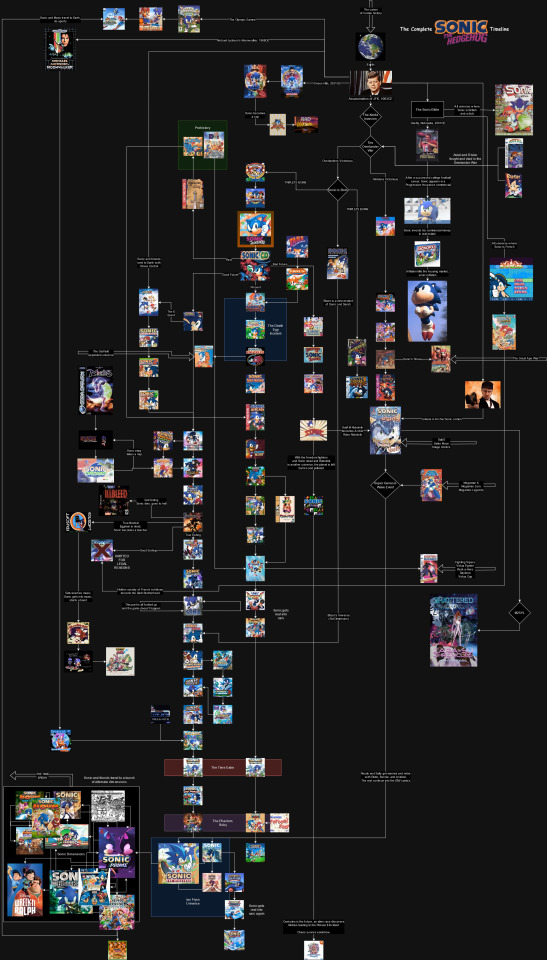
Oh it's me, I did that. My good friend Lizstar and I put together this totally accurate, complete, and not at all spurious, correct timeline of Sonic the Hedgehog.
Click the image link for the full size.
I will now take questions.
#sonic the hedgehog#sonic fandom#sonic frontiers#history#canon#jfk assassination#michael jackson#nights into dreams#space channel 5#archie sonic#fleetway sonic
66 notes
·
View notes
Text
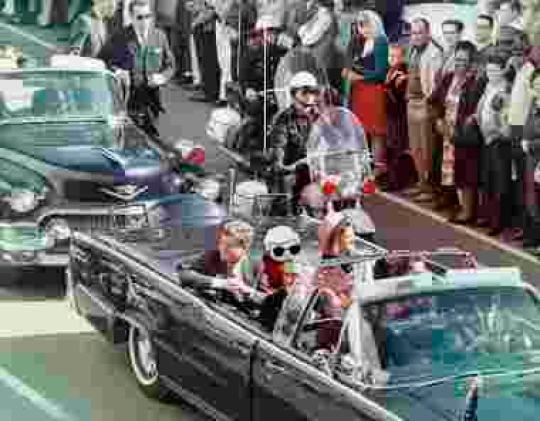

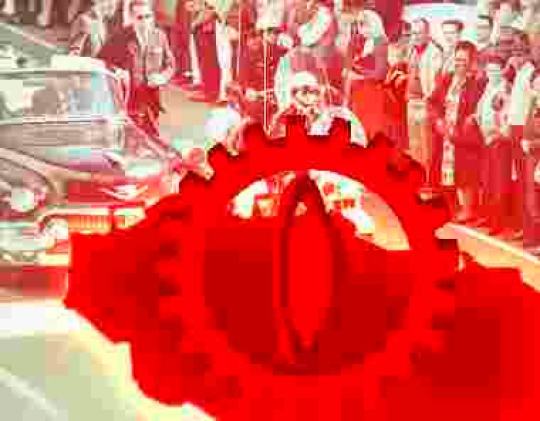
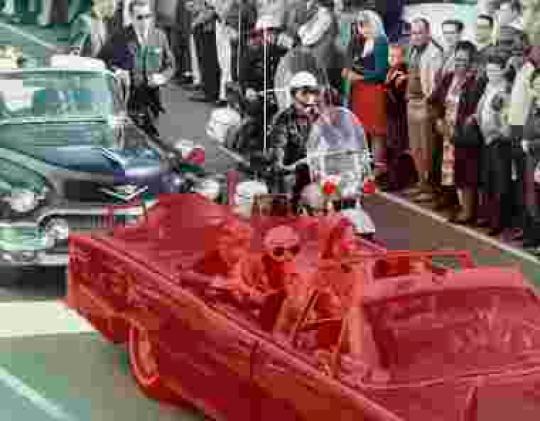
some photos recently unveiled by the Biden administration. What do you think? 😸
145 notes
·
View notes
Text
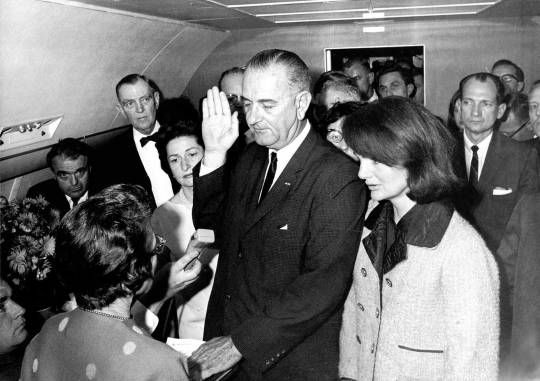
LETTERS FROM AN AMERICAN
November 22, 2023
HEATHER COX RICHARDSON
NOV 23, 2023
“It all began so beautifully,” Lady Bird remembered. “After a drizzle in the morning, the sun came out bright and beautiful. We were going into Dallas.”
It was November 22, 1963, and President John F. Kennedy and First Lady Jacqueline Kennedy were visiting Texas. They were there, in the home state of Vice President Lyndon Baines Johnson and his wife, Lady Bird, to try to heal a rift in the Democratic Party. The white supremacists who made up the base of the party’s southern wing loathed the Kennedy administration’s support for Black rights.
That base had turned on Kennedy when he and his brother, Attorney General Robert F. Kennedy, had backed the decision of the U.S. Court of Appeals for the Fifth Circuit in fall 1962 saying that army veteran James Meredith had the right to enroll at the University of Mississippi, more commonly known as Ole Miss.
When the Department of Justice ordered officials at Ole Miss to register Meredith, Mississippi governor Ross Barnett physically barred Meredith from entering the building and vowed to defend segregation and states’ rights.
So the Department of Justice detailed dozens of U.S. marshals to escort Meredith to the registrar and put more than 500 law enforcement officers on the campus. White supremacists rushed to meet them there and became increasingly violent. That night, Barnett told a radio audience: “We will never surrender!” The rioters destroyed property and, under cover of the darkness, fired at reporters and the federal marshals. They killed two men and wounded many others.
The riot ended when the president sent 20,000 troops to the campus. On October 1, Meredith became the first Black American to enroll at the University of Mississippi.
The Kennedys had made it clear that the federal government would stand behind civil rights, and white supremacists joined right-wing Republicans in insisting that their stance proved that the Kennedys were communists. Using a strong federal government to regulate business meant preventing a man from making all the money he could; protecting civil rights would take tax dollars from white Americans for the benefit of Black and Brown people. A bumper sticker produced during the Mississippi crisis warned that “the Castro Brothers”—equating the Kennedys with communist revolutionaries in Cuba—had gone to Ole Miss.
That conflation of Black rights and communism stoked such anger in the southern right wing that Kennedy felt obliged to travel to Dallas to try to mend some fences in the state Democratic Party.
On the morning of November 22, 1963, the Dallas Morning News contained a flyer saying the president was wanted for “treason” for “betraying the Constitution” and giving “support and encouragement to the Communist inspired racial riots.” Kennedy warned his wife that they were “heading into nut country today.”
But the motorcade through Dallas started out in a party atmosphere. At the head of the procession, the president and first lady waved from their car at the streets “lined with people—lots and lots of people—the children all smiling, placards, confetti, people waving from windows,” Lady Bird remembered. “There had been such a gala air,” she said, that when she heard three shots, “I thought it must be firecrackers or some sort of celebration.”
The Secret Service agents had no such moment of confusion. The cars sped forward, “terrifically fast—faster and faster,” according to Lady Bird, until they arrived at a hospital, which made Mrs. Johnson realize what had happened. “As we ground to a halt” and Secret Service agents began to pull them out of the cars, Lady Bird wrote, “I cast one last look over my shoulder and saw in the President’s car a bundle of pink, just like a drift of blossoms, lying on the back seat…Mrs. Kennedy lying over the President’s body.”
As they waited for news of the president, LBJ asked Lady Bird to go find Mrs. Kennedy. Lady Bird recalled that Secret Service agents “began to lead me up one corridor, back stairs, and down another. Suddenly, I found myself face to face with Jackie in a small hall…outside the operating room. You always think of her—or someone like her—as being insulated, protected; she was quite alone. I don’t think I ever saw anyone so much alone in my life.”
After trying to comfort Mrs. Kennedy, Lady Bird went back to the room where her own husband was. It was there that Kennedy’s special assistant told them, “The President is dead,” just before journalist Malcolm Kilduff entered and addressed LBJ as “Mr. President.”
Officials wanted LBJ out of Dallas as quickly as possible and rushed the party to the airport. Looking out the car window, Lady Bird saw a flag already at half mast and later recalled, “[T]hat is when the enormity of what had happened first struck me.”
In the confusion—in addition to the murder of the president, no one knew how extensive the plot against the government was—the attorney general wanted LBJ sworn into office as quickly as possible. Already on the plane to return to Washington, D.C., the party waited for Judge Sarah Hughes, a Dallas federal judge. By the time Hughes arrived, so had Mrs. Kennedy and the coffin bearing her husband’s body. “[A]nd there in the very narrow confines of the plane—with Jackie on his left with her hair falling in her face, but very composed, and me on his right, Judge Hughes, with the Bible, in front of him and a cluster of Secret Service people and Congressmen we had known for a long time around him—Lyndon took the oath of office,” Lady Bird recalled.
As the plane traveled to Washington, D.C., Lady Bird went into the private presidential cabin to see Mrs. Kennedy, passing President Kennedy’s casket in the hallway.
Lady Bird later recalled: “I looked at her. Mrs. Kennedy’s dress was stained with blood. One leg was almost entirely covered with it and her right glove was caked…with blood—her husband’s blood. She always wore gloves like she was used to them. I never could. Somehow that was one of the most poignant sights—exquisitely dressed and caked in blood. I asked her if I couldn’t get someone in to help her change and she said, ‘Oh, no. Perhaps later…but not right now.’”
“And then,” Lady Bird remembered, “with something—if, with a person that gentle, that dignified, you can say had an element of fierceness, she said, ‘I want them to see what they have done to Jack.’”
LETTERS FROM AN AMERICAN
HEATHER COX RICHARDSON
#Letters from an American#Heather cox Richardson#history#JFK#the Presidency#racism#JFK Assassination#politics
35 notes
·
View notes
Text
hoping i'm the first person here to make miraculous ladybug/jfk assassination crossover art
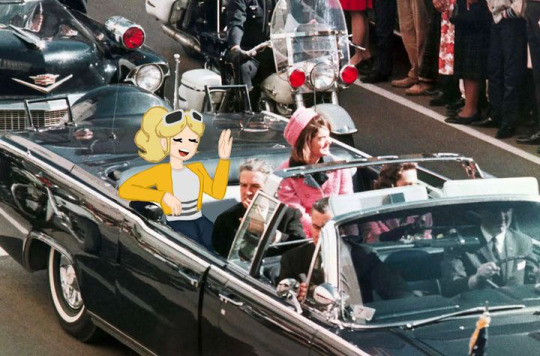

#miraculous fandom#miraculous fanart#miraculous adrien#adrien agreste#mlb adrien#miraculous lb#miraculous fanfic#mlb art#miraculous chat noir#chat noir#miraculous les aventures de ladybug et chat noir#miraculous spoilers#miraculous season 5#mlb collusion#mayor chloe#jfk assassination#mlb s5#mlb salt#chloe bourgeois#marinette dupain cheng#mlb ladybug
126 notes
·
View notes
Text
You Decide 🤔
#pay attention#educate yourselves#educate yourself#knowledge is power#reeducate yourself#reeducate yourselves#think for yourself#think for yourselves#think about it#question everything#ask yourself questions#do your homework#do your own research#do your research#do some research#jfk assassination#glenn beck
281 notes
·
View notes
Text
jfk assassination pride flag oc (jessie, she/fae)
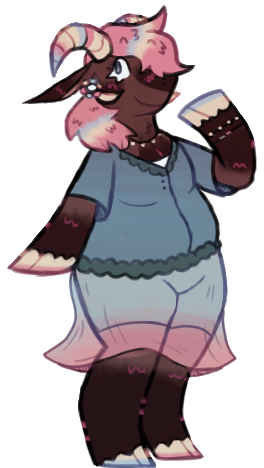

14 notes
·
View notes
Text

Lee Radziwill at the state funeral held for President John F. Kennedy on November 24th, 1963.
Also photographed are her mother Janet Auchincloss, step father Hugh D. Auchincloss, and her half brother James Auchincloss.
#lee radziwill#american vintage#iconic women#1960s#vintage beauty#60s#1960s fashion#1960s women#60s aesthetic#60s fashion#jfk assassination#american history#us history#jackie kennedy#fashion icon#washington dc#kennedy family#the kennedys#60s 70s 80s 90s#1960s history#1960s photography
28 notes
·
View notes
Text
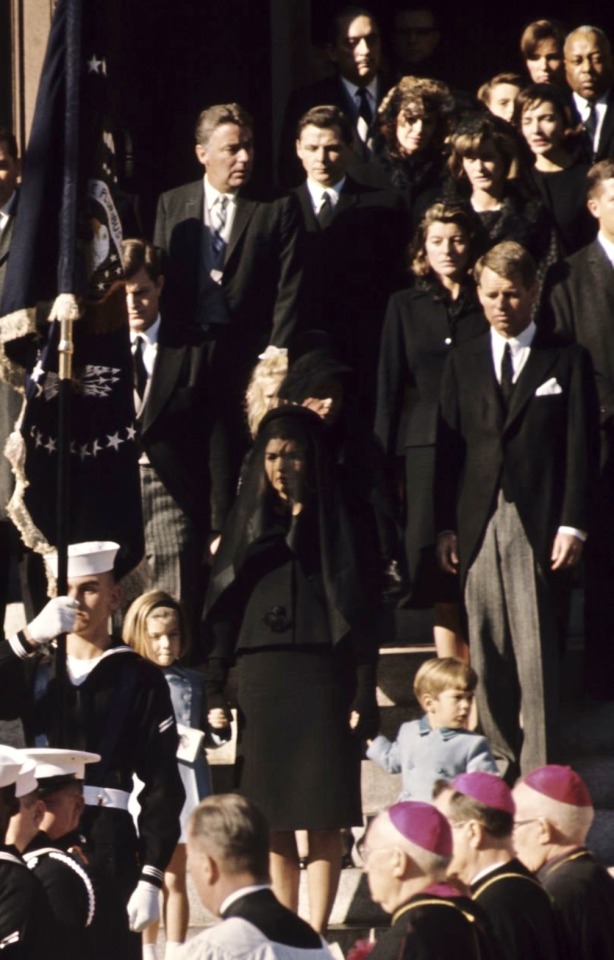
“All this pent up emotion in the Kennedy circle (not to mention the hundreds of thousands of letters of condolence that flooded into the office designated for Jackie in the executive office building) focused on the thirty four year old widow. It induced an abnormal atmosphere of suppressed hysteria, emotion, catatonic grief that marked Jackie for life. Even in her private life she became someone extraordinary, touched by fate and celebrity. No one would would ever be able to react normally to her again; nor would she ever, however hard she tried- and she did try- be able to escape her golden cage.”
- Sarah Bradford, excerpt from the biography “America’s Queen”
#jackie kennedy#john f kennedy#vintage#icons#the kennedys#jackie o#1960s#60s#60s icons#jfk#jacqueline kennedy#jackie onassis#first lady#jfk assassination#robert f kennedy#robert kennedy#lee radziwill#joan kennedy#ethel kennedy#pat kennedy#caroline kennedy#jfk jr.#john f kennedy jr#ted kennedy#kennedy family#rose kennedy#american history#american vintage#vintage celebrities#washington dc
70 notes
·
View notes